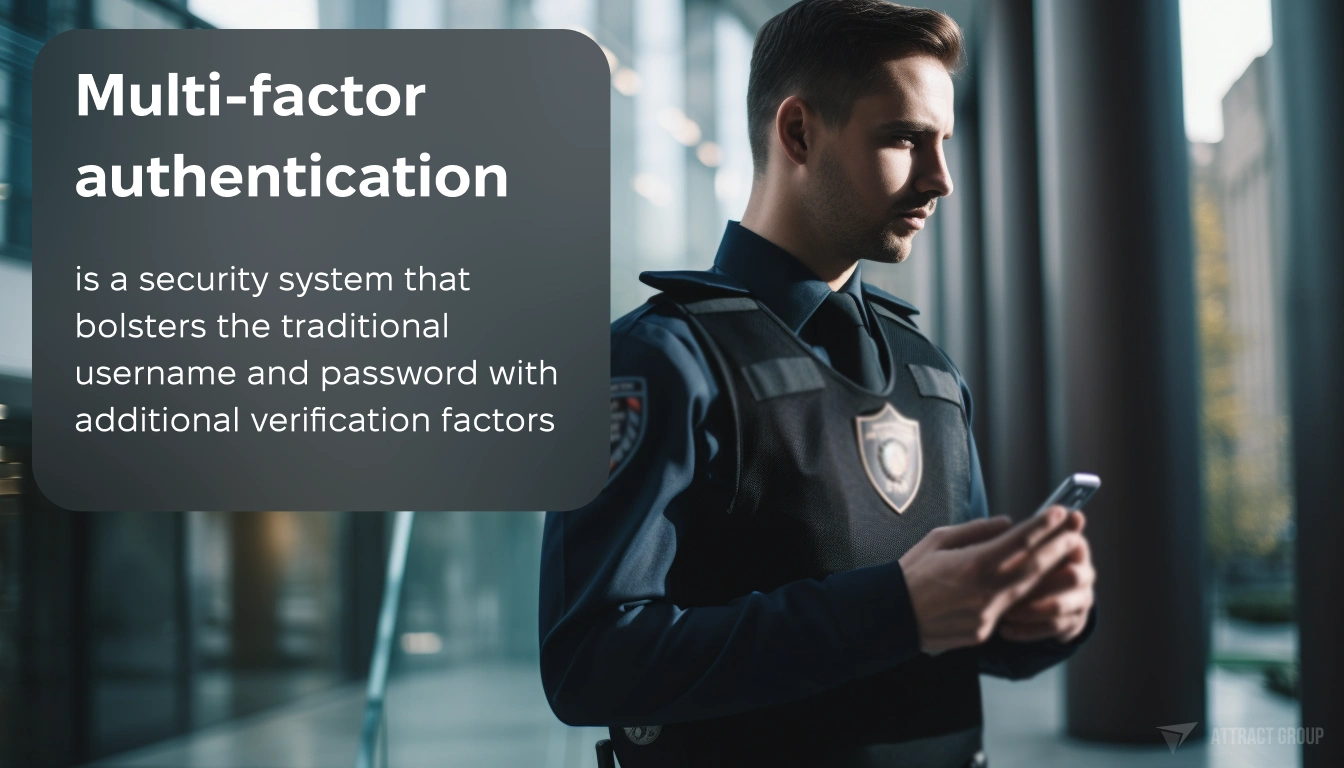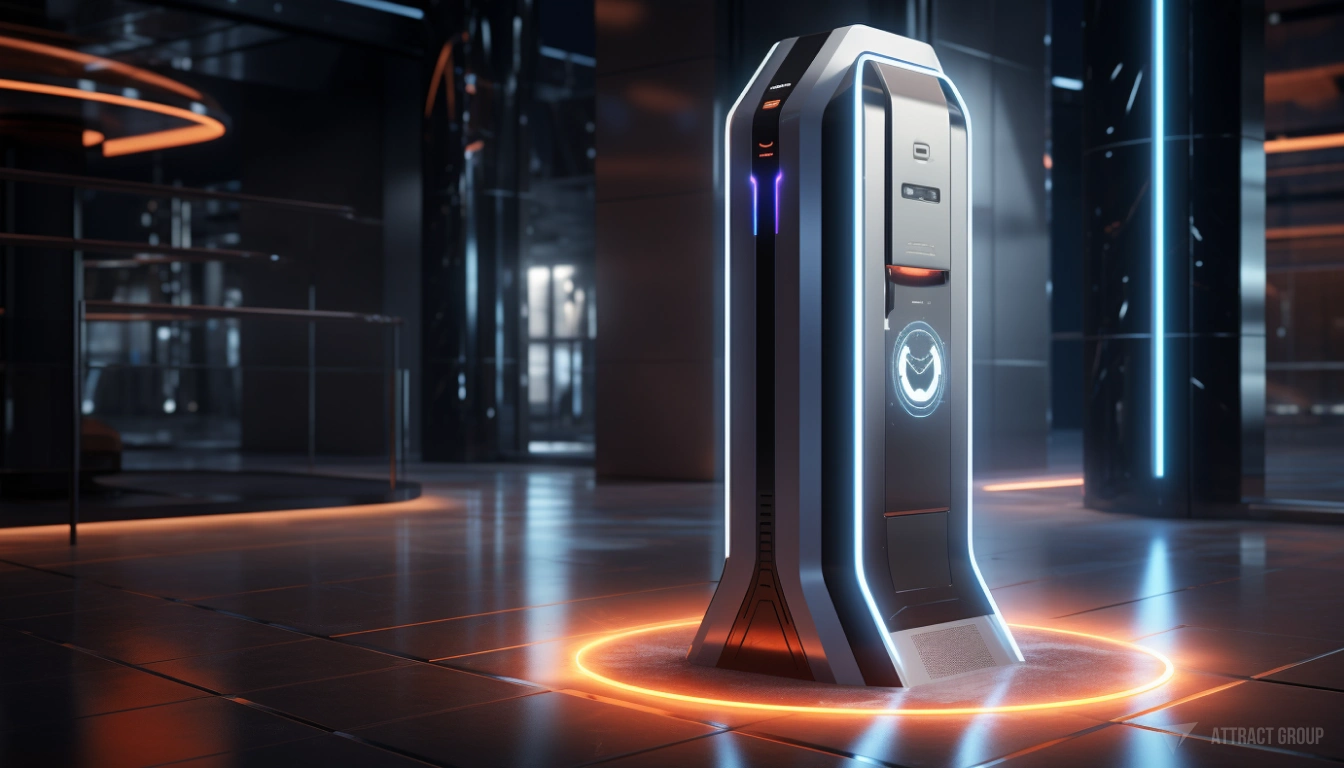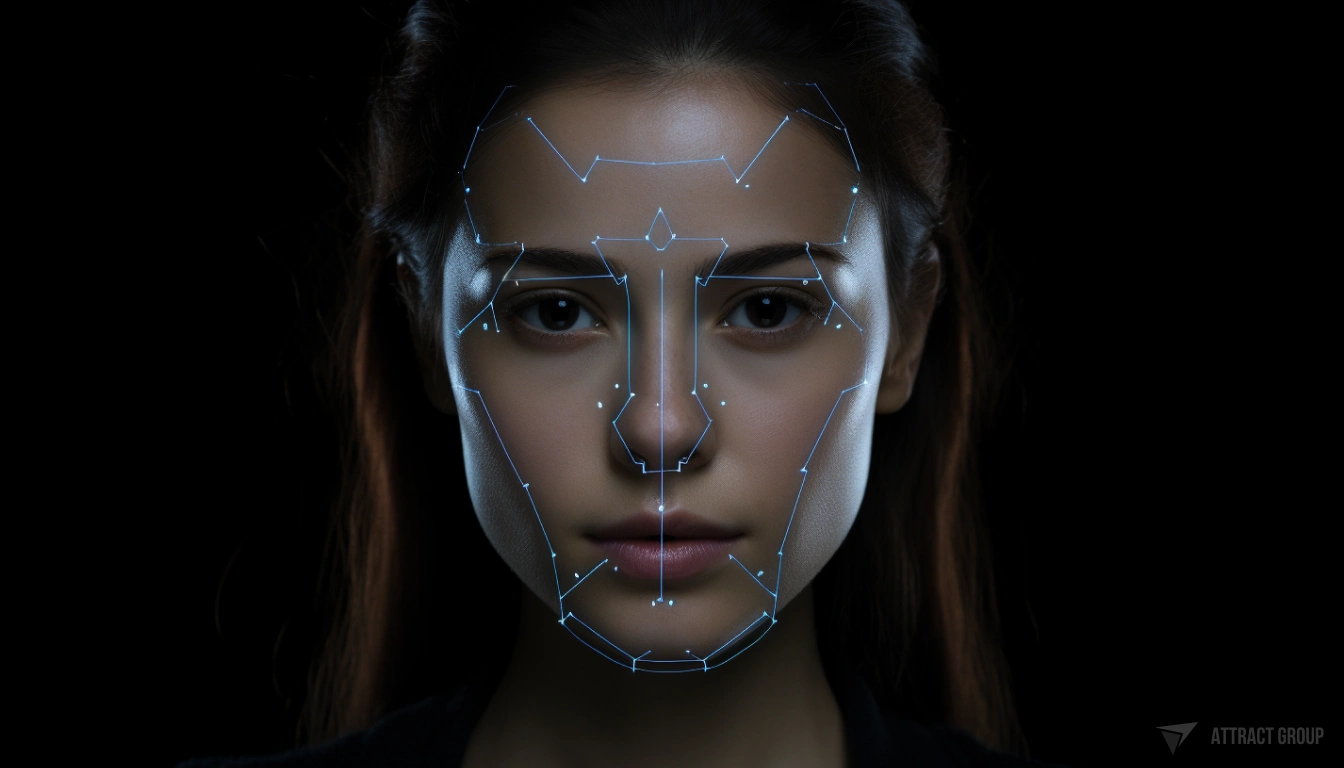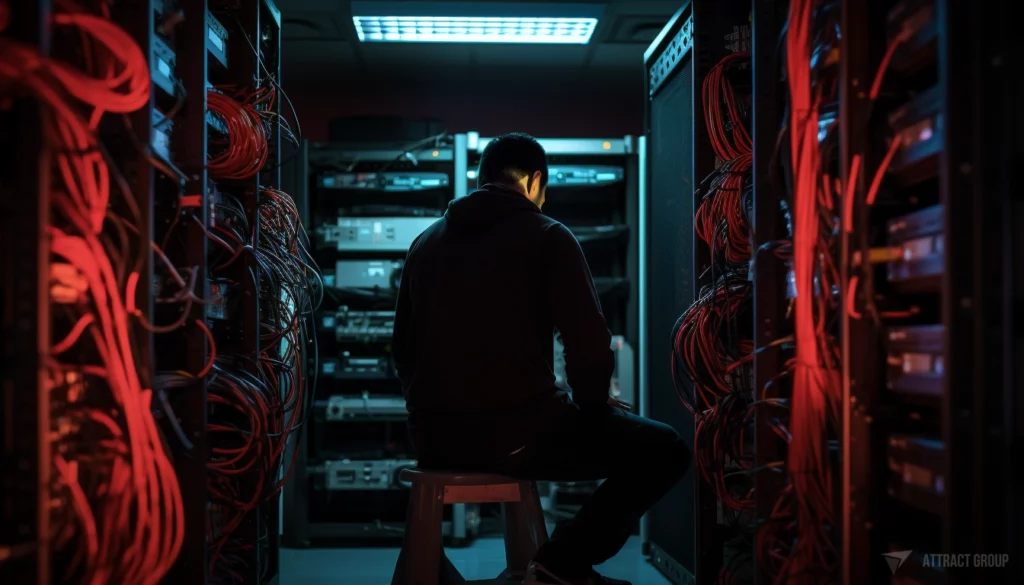Multi-Factor Authentication: Enhanced Security Guide
 8 February 2024
8 February 2024? Listen to the Summary of this article in Audio
In an age where digital threats are omnipresent, securing your virtual gateways with multi-factor authentication (MFA) is more than a recommendation. This robust enhanced security measure transcends traditional user authentication methods, integrating multiple layers to validate the identity of users and fortify their secure login credentials. As incidents of cyber exploits climb, adopting MFA is a proactive stride towards insulating your online presence against cybercriminals’ incessant onslaughts.
Embracing the dynamic duo of convenience and security, MFA stands as a sentinel, challenging unwelcome visitors with a compound checkpoint of credentials. It’s the paradigmatic shift in digital defense mechanisms, operating on the principle that multiple verification factors can significantly stonewall unauthorized access attempts. Whether for accessing bank accounts or safeguarding personal emails and social platforms, MFA acts as the linchpin for preserving the integrity of sensitive information and one’s digital identity.
Key Takeaways
- MFA is a critical defense layer, blending multiple verification factors to ascertain user identity.
- Adopting MFA markedly heightens security for online accounts, curtailing the risk of data theft and cyber intrusions.
- Financial institutions and savvy netizens are leveraging MFA for an extra security enclave, promoting a protected digital transaction space.
- MFA’s adaptability across personal and professional accounts administers an overarching cover against multifaceted cyber threats.
- With MFA, secure login practices evolve, transcending password dependency and fortifying user trust in digital systems.
Understanding the Basics of Multi-Factor Authentication
The landscape of digital security is ever-changing and complex, with multi-factor authentication (MFA) at the forefront of protecting users across various platforms. In an effort to deepen the understanding of MFA’s pivotal role in contemporary cybersecurity, this section delves into the core principles and components that comprise MFA’s robust framework.
What is Multi-Factor Authentication (MFA)?

Multi-factor authentication is a security system that bolsters the traditional username and password with additional verification factors. This ensures a layered defense against unauthorized entry, requiring a user to present two or more validation factors before gaining access. MFA’s design is rooted in the premise that each additional layer of authentication presents a separate obstacle for potential intruders, thereby tightening the security of user accounts and sensitive information.
How Does MFA Enhance User Authentication?
By integrating multiple independent credentials, MFA adds depth and complexity to user authentication processes. It operates beyond the realm of simple password protection, creating a dynamic barrier that adapts to an array of authentication methods. The added security measures considerably diminish the chances of unauthorized access, elevating the protective measures in place for digital identities and assets.
The Three Authentication Factors: Knowledge, Possession, and Inherence
At its core, MFA is structured around three distinct categories of verification factors that together fortify the authentication routine:
- Knowledge: Something only the user knows, such as a password or PIN.
- Possession: Something the user has in their possession, such as a mobile device for receiving OTPs (One Time Passwords) or a security token.
- Inherence: Something inherent to the user’s physical being, ranging from fingerprints to facial recognition, emphasizing biometric verifications.
To offer a clear visual representation, below is a table showcasing examples of each authentication factor:
| Factor Category | Examples |
|---|---|
| Knowledge | Passwords, Security Questions, PINs |
| Possession | Smart Cards, Authenticator Apps, Hardware Tokens |
| Inherence | Fingerprint Scanners, Facial Recognition Systems, Voice Biometrics |
In combining these factors, MFA provides a comprehensive approach to securing user accounts. By mandating multiple proofs of identity, MFA stands as a critical component in the modern digital security toolkit, promising a significant decrease in the likelihood of compromise from cyber threats.
Get a free consultation from our cybersecurity experts on implementing a customized MFA system to protect your organization.
The Importance of Multi-Factor Protection
As digital engagement intensifies, the specter of security breaches looms larger by the day, compelling us to reassess our defenses against the sophisticated tactics of modern threat actors. In this context, multi-factor protection has transformed from a secured luxury to an indispensable shield in the user’s cybersecurity arsenal, bolstering defenses where traditional methods falter.
Rise of Security Breaches and Identity Theft
In the daunting reality of relentless digital threats, identity theft and security breaches have surged, posing grave concerns for individuals and enterprises alike. This pervasive uptick underscores a pressing need for more robust authentication mechanisms capable of repelling sophisticated hacks and unauthorized entry, spotlighting the critical role MFA plays in the current cybersecurity paradigm.
Strong Authentication as a Shield Against Cyber Attacks
Immersing into the depths of multi-factor protection, we quickly perceive its efficacy as a bulwark against cyber incursions. The additional verification layers required by MFA render futile the attempts of intruders armed with stolen credentials, substantially reducing the incidence and impact of cyber attacks on digital fortresses.
NIST Recommendations for MFA Usage
Guidance from the National Institute of Standards and Technology (NIST) advocates strongly for the adoption of MFA, particularly when it involves safeguarding our most precious digital assets. NIST heralds MFA as a cornerstone in the quest to secure sensitive data across email, financial, and health-related platforms, nudging organizations and users towards integrating this powerful guard into their security regimes.
Whether MFA is a requisite or a discretionary measure, the evidence favoring its activation is incontrovertible. In bolstering our digital defenses with multi-factor protection, we not only heed the wise counsel of NIST, but take a resolute step towards securing our digital identity against the incessant tide of cyber threats.
Exploring Different Multi-Factor Authentication Methods
With the increasing pervasiveness of digital interactions, secure user verification is paramount. Navigating through the myriad of multi-factor authentication methods available can be daunting; however, understanding the diverse options plays a crucial role in enhancing cybersecurity. MFA technology not only deters unauthorized access but also instills confidence in digital transactions, thereby solidifying its status as an indispensable asset in the realm of online security.
Diving into the spectrum of authentication methods, we encounter traditional approaches such as passwords, which, when combined with modern advancements, yield a fortified security framework. Cutting-edge biometric solutions like fingerprint scanning, facial recognition, and voice recognition are increasingly becoming the cornerstones of sophisticated multi-factor authentication methods, offering both heightened security and user-friendly verification processes.
In the pursuit of robust security protocols, a blend of something you know with something you have or something you are becomes a formidable barrier against cyber threats. The evolution of MFA technology now allows for an agile response to the multi-faceted landscape of digital security, where each additional factor significantly reduces the window of opportunity for potential breaches.
The table below highlights the various MFA factors and examples, painting a clearer picture of the dynamic ecosystem of authentication tools at a user’s disposal. Each method contributes to a layered defense strategy, which is essential to establish a secure user verification protocol.
| Factor | Examples | Security Benefit |
|---|---|---|
| Knowledge-Based Factors | Passwords, PINs, Security Questions | User-specific information that is difficult for others to guess |
| Possession-Based Factors | Security Tokens, Mobile OTP Apps, Smart Cards | Physical or digital items that the user must have at hand to authenticate |
| Inherence-Based Factors | Fingerprint Scanners, Facial Recognition, Voice Biometrics | Unique user characteristics that cannot be easily replicated or stolen |
Through the strategic application of these MFA technology components, stakeholders can create a formidable digital fortress. The selection of MFA mechanisms must align with both the sensitivity of the information being protected and user convenience, striking a balance that fosters widespread adoption and effective security management.
Organizations and individuals must proactively embrace these sophisticated multi-factor authentication methods, as they formulate a critical line of defense in safeguarding against the increasing sophistication of cyber threats. Trust in MFA technology is not just about adopting a new system; it’s about creating a culture of security awareness where each layer of verification is understood, implemented, and maintained as part of a robust cybersecurity framework.
Secure Login: Implementing MFA Across Your Digital Accounts
The digital age demands a relentless focus on security — particularly the secure login practices that guard our virtual lives. As multi-factor authentication (MFA) has become increasingly crucial, its implementation across digital accounts has emerged as an imperative step for individuals and organizations alike. The following sections outline the key strategies for activating MFA to ensure that your digital transactions are safe and that your personal data remains confidential.

Activating MFA on Email and Social Media Platforms
For most users, email and social media accounts are the central hubs of their online activity, and as such, vulnerable to cyber-attacks. The activation of MFA on these platforms significantly decreases the risk of unauthorized access. Major email providers such as Gmail, Outlook, and Yahoo, alongside social media giants like Facebook, Twitter, and LinkedIn, offer straightforward options to enable MFA. Typically, this involves logging into account settings and following the security prompts to add an additional verification layer, such as a mobile device notification or an authentication app code.
MFA Configuration for Financial and Health Records
Securing financial and health records is paramount given the sensitive nature of the data involved. With cybercriminals targeting these sectors for their high-value information, MFA serves as a vital shield to protect against identity theft and financial fraud. MFA implementation in banking and healthcare portals is often mandatory, and for a good reason. Activating it is usually a straightforward process via the institution’s app or website, where you may set up verification codes sent via SMS or generated through a secure token.
Setting Up Strong Authentication on Various Devices
The multitude of smart devices we use — from mobile phones to laptops — can be both a boon and a bane for cybersecurity. Each device serves as a potential entry point for unauthorized users but is also an asset when it comes to setting up MFA. Users should ensure that MFA is activated on all devices where digital accounts can be accessed. This might involve adding biometric data like fingerprints or facial recognition, using trusted devices, or pairing a smart device with a secure app that generates time-sensitive authentication codes.
To eloquently visualize the scope of MFA activation, consider the following representation:
| Platform | MFA Method | User Action Required |
|---|---|---|
| Email (e.g., Gmail, Outlook) | Authentication App, SMS | Access Settings, Configure MFA |
| Social Media (e.g., Facebook, Twitter) | Security Notifications, Authentication App | Visit Security Settings, Enable MFA |
| Banking/Financial Services | SMS, Security Tokens | Log into Online Banking, Activate MFA as prompted |
| Healthcare Portals | SMS, Email Verification | Navigate to Profile Settings, Set Up MFA |
As technology advances, so too do the methods of exploitation used by cybercriminals. It is crucial to couple our evolving digital lifestyles with robust security measures. The steps to activate MFA are simple, yet they establish a critical defense in safeguarding our online interactions. For additional guidance on enhancing your cybersecurity, refer to resources like the Cybersecurity & Infrastructure Security Agency at www.cisa.gov/ncsam, and remember: In the digital realm, the activation of multi-factor authentication is not just a best practice — it is a necessity.
Our IT professionals can assist with smoothly integrating MFA into your digital platforms and training your staff on proper usage.
Step-by-Step Guide to Deploying Multi-Factor Authentication Solutions
Deploying multi-factor authentication (MFA) within an organization is a layered process that involves careful planning and execution to enhance security protocols effectively. By integrating advanced authentication technology, businesses can significantly improve their defense against unauthorized access. The procedure detailed here serves as a guide to ensure a smooth MFA rollout.
Evaluating Organizational Needs for MFA
Before introducing an MFA solution, it is crucial to conduct an in-depth analysis of the company’s security infrastructure and pinpoint areas most vulnerable to potential breaches. This evaluation should consider the types of data managed, the severity of potential cyber threats, and the necessity for varying levels of access control within distinct departments.
Selecting and Configuring the Right MFA Tool
Once the needs assessment is complete, the next step is to select an MFA solution that aligns with the organization’s security requirements and user-friendliness criteria. Renowned tools such as Google Authenticator, Microsoft Authenticator, and Duo Security are among the leading options. Configuration involves setting up the selected tool to synchronize seamlessly with existing organizational systems, ensuring minimal disruption during the integration phase.
Testing and Verifying MFA Effectiveness
Post-configuration, rigorous testing of the MFA framework is imperative. This phase should simulate various user scenarios including remote work access and diverse device usage, to assess the tool’s robustness. Additionally, verifying that users are well-instructed on the new procedures confirms the scalability of the solution while fine-tuning user experience, leading to widespread acceptance and adherence.

The rollout of an MFA solution is a cornerstone in safeguarding an enterprise’s digital footprint. The relevant keywords for this initiative include deploying multi-factor authentication, MFA solution, and authentication technology, each playing a pivotal role in advancing an organization’s security agenda. Documentation of this journey is equally important, as it serves as a guide for ongoing maintenance and future security initiatives.
Successfully deploying multi-factor authentication goes beyond the initial implementation; it demands sustained oversight and adaptation in response to emerging security trends and technologies. This commitment ensures that the protection provided by MFA solutions remains robust and continues to meet the evolving security needs of the organization.
For organizations looking to strengthen their cybersecurity posture, embracing MFA is not an option but a necessity. Through the step-by-step guide outlined above, companies can navigate the complexities of deploying a robust MFA solution, ensuring a secure and resilient digital environment for their stakeholders.
Let our IT consultants guide you through selecting, configuring, and rolling out multi-factor authentication across your organization.
Integrating Multi-Factor Authentication with Single Sign-On (SSO)
The seamless integration of multi-factor authentication (MFA) with Single Sign-On (SSO) represents a transformative leap in user access management. This powerful combination not only reinforces security parameters but also streamlines the user experience, creating an efficient and secure gateway to a multitude of applications and services.
In the digital ecosystem, where myriad applications are interwoven into the daily operations of businesses, the need for an authentication process that is both secure and user-friendly cannot be overstated. SSO enables users to authenticate once and gain access to multiple systems, and when underpinned by robust MFA protocols, it substantially mitigates the risk of unauthorized access.
Identity providers such as Okta and Azure Active Directory are at the forefront of offering solutions that effectively marry MFA with SSO, producing a harmonized authentication framework. Thus, users enjoy the convenience of simplified logins while benefiting from the added security of MFA — protecting their credentials and sensitive corporate data from potential security breaches.
Let’s explore the benefits that this integration brings to an organization’s security posture through exemplary identity providers:
| Identity Provider | SSO Feature | MFA Feature | Integration Benefit |
|---|---|---|---|
| Okta | Universal Directory for centralizing user management | Adaptive MFA with flexible policy-driven security | Customizable security that adjusts to user behavior and requirements |
| Azure Active Directory | Single sign-on support across cloud and on-premise apps | Conditional Access driven MFA | Security enforced based on user context and risk level |
With multi-factor authentication integration, organizations find a balance between assertive security measures and operational efficiency. Firms utilizing these technologies appreciate a reduction in both security incident frequency and helpdesk costs associated with password recoveries.
In an environment where cyber threats are in constant flux, the partnership between MFA and SSO delivers an agile, fortified line of defense. It represents a strategic approach in user access management, ensuring that user identities are thoroughly verified before granting access and that sensitive corporate information remains within the confines of authenticated user activities.
The Impact of Passwordless Authentication on Security Protocols
As the digital industry continues to wrestle with data breaches and hacking incidents, passwordless authentication has emerged as a beacon of innovation ushering in an era of refined security protocols. Captivated by its promise for tighter security and a slimmer chance of cyber-attacks, institutions and individuals are becoming keen adopters of the passwordless paradigm, marking a significant milestone in the user authentication evolution.
How Passwordless Authentication Works
Forgoing the traditional reliance on memorized secret codes, passwordless authentication leverages user-friendly methods such as biometric verification, one-time codes, or authenticated devices. These alternatives to passwords simplify the login process while enhancing security. With growing technological ease, users now gain access by presenting a fingerprint, enunciating a phrase, or connecting a trusted device, assuring that only legitimate and authorized personnel can cross the digital threshold.

Comparing Passwordless and Traditional MFA Methods
The evolution from classic multi-factor authentication to passwordless methods is best understood through comparison. Traditional MFA requires the amalgamation of ‘something you know’ with ‘something you have’ or ‘something you are’ for user verification. Although effective, this can sometimes create friction for the user. Passwordless systems streamline this process by removing the ‘something you know’ component, often resulting in a more pleasant user experience and, crucially, maintaining, if not elevating, security measures.
Transitioning to a Passwordless Future
The march towards a passwordless future is characterized by its steady elimination of problematic password-related issues such as phishing, reuse across different sites, and the all-too-common human error of creating weak passwords. Businesses embracing passwordless authentication reap the benefits of a more secure, efficient, and user-friendly experience. The future, where accessing our digital assets is as natural and secure as unlocking a car with a key fob, is not a distant dream but an impending reality.
To encapsulate the transformation brought by passwordless methods to security protocols, here’s a comparative table highlighting the core differences between passwordless authentication and traditional MFA mechanisms:
| Authentication Method | Passwordless | Traditional MFA |
|---|---|---|
| User Verification | Biometrics, Hardware Tokens | Passwords, One-Time Codes |
| Security Level | Potentially Higher | Varies with Password Strength |
| User Experience | Streamlined and Convenient | Can be Cumbersome |
| Error Prone | Lower Risk of User Errors | Higher Risk of User Errors |
| Adaptation to New Technologies | Faster | Slower |
As we witness this transformative phase in cybersecurity measures, it is clear that passwordless authentication stands not just as another alternative, but as an essential advancement in the pursuit of robust, effortless, and user-centric security protocols.
Enhancing Authentication Security Through Biometric Verification
In the pursuit of elevating authentication security within digital realms, biometric verification stands as a hallmark of innovative protection strategies. Biometric technologies harness the unique physical characteristics of individuals to provide robust defense mechanisms against identity-related cyber threats. This section delves into the intricacies of biometric verification and its significance in the tapestry of cybersecurity measures.
Fingerprint, Facial, and Voice Recognition Technologies
The triumvirate of biometric technologies — fingerprint, facial, and voice recognition — has revolutionized the way we ascertain identity and control access. These biometric verification tools compare physiological indicators against stored biometric data to authenticate individuals with precision and speed. It’s an authentication security approach that leverages the inherent complexity of human biology to fortify digital protections.
Benefits and Challenges of Biometric Authentication
Biometric authentication proffers numerous benefits, such as a streamlined authentication process and a higher degree of accuracy in identifying authorized users. The protection from credential theft is intensified as the biometric traits required for access are inherently non-transferrable and difficult to replicate. However, despite the advantages, implementation challenges, including system vulnerabilities and potential technical errors, pose concerns that merit attention. Adopting such biometric technologies must also consider inclusivity and the capacity to accommodate all users effectively.
Privacy and Ethical Considerations in Biometric Data Usage
The intersection of biometric data usage with privacy and ethical standards is complex. The sensitive nature of biometric information demands rigorous data protection protocols and transparent policies to ensure ethical handling. Organizations must navigate the intricacies of user consent, data storage, and ethical use of biometric data to uphold the trust users place in their security frameworks.
| Biometric Technology | Security Features | Common Applications | Challenges |
|---|---|---|---|
| Fingerprint Recognition | Unique patterns make duplication tough | Mobile devices, Time attendance systems | Can be affected by skin conditions |
| Facial Recognition | Rapid processing and contactless usage | Device security, Surveillance | Subject to lighting and obstructions |
| Voice Recognition | Convenience of verbal commands | Virtual assistants, Banking systems | Vulnerable to background noise |
As we adopt these sophisticated biometric systems, conducting thorough risk assessments, scrutinizing the robustness of technological implementations, and engaging in continual dialogue regarding ethical considerations are essential steps. This ensures biometric verification not only augments authentication security but also aligns with our shared values of privacy and ethical stewardship.

Best Practices for MFA Deployment in Enterprise Environments
In today’s digital age, where security breaches are increasingly common, enterprise security has become a critical aspect that no organization should overlook. Among various security measures, Multi-Factor Authentication (MFA) stands out as a key player in defending against unauthorized access. To ensure effective MFA deployment in enterprise environments, adhering to certain authentication best practices can help fortify an organization’s defensive posture.
One of the initial steps in deploying MFA is conducting a thorough risk assessment. This involves identifying sensitive areas within the IT infrastructure that require enhanced security measures. By pinpointing these critical points, deploying MFA becomes strategic and intentional, boosting the overall security of the corporate ecosystem.
After assessing risks, it is indispensable to select and configure the appropriate MFA solution tailored to the unique requirements of the organization. User-friendliness and integration with existing systems should be considered to ensure a smooth transition and high adoption rates among staff.
Moreover, monitoring the usage of MFA is integral to maintaining its efficacy. This ongoing process helps in quickly identifying any unusual patterns that may indicate attempted breaches or system vulnerabilities. Regularly reviewing and updating MFA-related policies also ensures alignment with current security trends and standards.
Educational initiatives for staff members about the significance and usage of MFA cannot be understated. Continuous training fosters an informed workforce capable of recognizing security threats and adhering to best practices.
Incorporating MFA in third-party services and strongly advocating its use for remote access safeguards sensitive information that could otherwise be at risk due to less secure external platforms or networks.
Security audits are crucial and should be performed regularly to validate the strength of MFA deployments. These audits aid in uncovering potential flaws in the system, allowing for timely enhancements or modifications.
Below is an encompassing guide in the form of a table that businesses can reference when planning to deploy MFA within their operations:
| Best Practice | Objective | Action Items |
|---|---|---|
| Risk Assessment | Identify sensitive areas requiring MFA | Evaluate data access points, establish priority areas for MFA application |
| Select & Configure MFA Solution | Implement an MFA system compatible with organizational needs | Research vendors, consider user experience, ensure system compatibility |
| Monitor MFA Usage | Oversee authentication attempts, identify anomalies | Set up alerts for failed login attempts, review access logs |
| Policy Review & Update | Ensure MFA policies are current and robust | Regularly assess policy effectiveness, update per new threats or technologies |
| Education & Training | Increase awareness about MFA importance and operation | Conduct training sessions, simulations, provide educational materials |
| MFA for Third-Party Services | Extend security measures to external services | Require MFA for vendor access, examine third-party security standards |
| Security Audit | Examine the integrity of the MFA deployment | Schedule regular audits, engage with security professionals for assessments |
Employing MFA is widely considered a necessary step for organizations seeking to protect their assets and mitigate the risk of unauthorized access—essentially becoming a cornerstone of modern enterprise security. However, successful MFA deployment is not just about technology installation but also involves a strategic blend of assessment, configuration, vigilance, policy management, and user empowerment. By merging these key considerations into a cohesive strategy, enterprises can significantly enhance their security posture and resilience against cyber threats.
Conclusion
In the current digital era, the urgency of fortifying our online defenses has led to an irrefutable consensus: the adoption of multi-factor authentication (MFA) is not just beneficial, but a necessity. As we have navigated through the intricacies of MFA, it has become increasingly clear that securing our digital identity is paramount. The assurance MFA provides, serving as the final bulwark against cyber threats, solidifies its position as an indispensable asset in our cyber security toolkit.
The Final Layer: Why Multi-Factor Authentication is Non-Negotiable
The pervasive nature of cyber risks demands that individuals and organizations alike regard the implementation of MFA as an essential, non-negotiable component of their security protocols. MFA’s efficacy in mitigating risks associated with compromised credentials renders it a critical element in safeguarding our digital footprint. With profound shifts in how we interact with technology and sensitive data, multi factor authentication adoption is the cornerstone that reinforces the security of our online activities.
Future-Proofing Your Security Posture with MFA
To stay ahead of the constantly evolving threats in cyberspace, future-proofing our security measures is imperative. MFA serves as a dynamic shield, adaptable to the ever-changing tactics employed by cyber adversaries. Its robust, multi-layered approach ensures that businesses and individuals maintain a resilient defense mechanism, prepared to deflect the numerous types of attacks that the future may hold. Integrating MFA into our digital practices is, therefore, not just prudent; it is a proactive step towards ensuring enduring security.

Embracing MFA for a Safer Online Presence
Embracing MFA is a definitive stride towards a safer online presence. By implementing this advanced form of authentication, users significantly enhance the security of their personal and professional data. The collective effort to incorporate MFA across platforms fosters a cyber environment where safety and trust prevail. In our pursuit of a secure digital society, the role of MFA is instrumental, and its widespread application is a testament to our commitment to securing digital identities and assets against the sophistication of contemporary cyber threats.
Connect with our cybersecurity professionals to implement robust multi-factor authentication tailored for your unique needs.
FAQ
What is Multi-Factor Authentication (MFA)?
Multi-Factor Authentication (MFA) is a security process that requires users to provide multiple forms of verification to authenticate their identity. By combining at least two independent credentials from the categories of knowledge (something you know), possession (something you have), and inherence (something you are), MFA strengthens security and deters unauthorized access.
How Does MFA Enhance User Authentication?
MFA enhances user authentication by adding layers of security beyond just a password. This makes it significantly more challenging for cybercriminals to gain unauthorized access because they would need to compromise multiple authentication factors, not just one, thereby increasing the effort and complexity involved in any potential breach.
What are the Three Authentication Factors: Knowledge, Possession, and Inherence?
The three categories of authentication factors include knowledge factors, like passwords or PIN codes; possession factors, such as bank cards or mobile devices; and inherence factors, which involve biometrics like fingerprints or facial recognition. Using multiple factors from different categories enhances the security of the authentication process.
Why are Security Breaches and Identity Theft on the Rise?
Security breaches and identity theft are on the rise due to the increasing value of personal information in the digital age and the sophistication of cybercriminal tactics. The proliferation of online services and data also creates more opportunities for breaches, underscoring the need for robust security measures like MFA.
What is Strong Authentication, and how does it act as a Shield Against Cyber Attacks?
Strong Authentication is an enhanced security process that confirms a user’s identity by requiring multiple authentication factors. It serves as a shield against cyber attacks by creating a more complex defense system that is difficult for attackers to penetrate, thus protecting sensitive information and accounts.
What are the NIST Recommendations for MFA Usage?
The National Institute of Standards and Technology (NIST) recommends the routine use of Multi-Factor Authentication (MFA), especially when it involves sensitive information such as primary email, financial services, and health records. NIST guidelines encourage the application of MFA to minimize the risk of unauthorized access and data breaches.
How Should You Activate MFA on Email and Social Media Platforms?
To activate MFA on email and social media platforms, you typically need to visit the security settings of your accounts, select the option to enable MFA, and follow the instructions provided. This may involve setting up a secondary authentication method like a mobile app, text message, or security key.
How do You Configure MFA for Financial and Health Records?
Configuring MFA for financial and health records involves accessing the security settings of your accounts, choosing to enable MFA, and selecting a verification method, such as a mobile authenticator app, text messages, or email verification. Each institution will have specific steps to follow and may offer additional proprietary methods.
What are the Steps for Setting Up Strong Authentication on Various Devices?
Setting up strong authentication involves accessing the device’s security settings and enabling MFA options, which may include registering a fingerprint, facial recognition, or receiving a verification code via text or authentication app. Ensure that MFA settings are applied consistently across all devices you use for a unified security approach.
What Should Organizations Consider When Evaluating MFA Needs?
Organizations should evaluate the sensitivity of the data they handle, the risk of unauthorized access, the nature of their business, and the user experience. They must consider regulations and compliance requirements, existing infrastructure, and resource availability for implementing MFA solutions.
How do You Select and Configure the Right MFA Tool?
Selecting and configuring the right MFA tool involves assessing the compatibility with your existing systems, user-friendliness, the types of supported authentication methods, and scalability. Look for trusted solutions known for strong security measures and clear documentation for configuration and deployment.
Why is Testing and Verifying MFA Effectiveness Important?
Testing and verifying MFA effectiveness is essential to ensure that the authentication methods are working as intended and provide the required security level. It also helps identify any user experience issues or potential vulnerabilities that need to be addressed before widespread rollout.
How does Passwordless Authentication Impact Security Protocols?
Passwordless authentication impacts security protocols by removing passwords as a potential vulnerability. Instead, it relies on more secure methods like biometrics or physical tokens, which are less susceptible to theft and phishing, ultimately enhancing overall security architecture.
What is the Process for Transitioning to a Passwordless Future?
The transition to a passwordless future involves adopting technologies like biometric authentication, mobile apps, or security keys as primary methods for user verification. Organizations need to upgrade infrastructure, educate users, and implement new policies to accommodate passwordless systems seamlessly.
What are Best Practices for MFA Deployment in Enterprise Environments?
Best practices for MFA deployment in enterprise environments include conducting a risk assessment, choosing a scalable MFA solution, integrating MFA with existing systems like SSO, continuous user training, monitoring usage, updating policies regularly, and including MFA for remote access and third-party services.









